|
|
|
Sort Order |
|
|
|
Items / Page
|
|
|
|
|
|
|
| Srl | Item |
| 1 |
ID:
155825
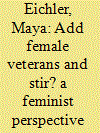

|
|
|
|
|
| Summary/Abstract |
This article examines how scholarship on veterans has begun to incorporate gender as a relevant category of research. Drawing on feminist theory, it identifies different approaches to gender within the field of veterans studies and suggests avenues for advancing this aspect of research. The vast majority of gender research on veterans treats gender as a descriptive category or variable through a focus on female veterans or gender differences. This article argues that research on veterans can be enriched by employing gender as an analytical category. Focusing on gender norms, power and inequality based on gender, and the intersections of gender with other categories of social difference opens up new questions for gender research on veterans. This kind of broader, analytical conceptualization of gender reveals the ways in which gender shapes the transition to civilian life for all veterans and how veterans policies and programs impact gender relations.
|
|
|
|
|
|
|
|
|
|
|
|
|
|
|
|
| 2 |
ID:
155824


|
|
|
|
|
| Summary/Abstract |
Children in military families experience various stressors associated with the demands of military life, such as parental absences due to deployments. However, there is a limited understanding of children’s well-being to parental deployment from Canadian military families. This study was conducted to examine the impact of deployment on the well-being of school age children from Canadian Armed Forces families and to consider the resilience factors in their well-being. Focus groups with children (N = 85) showed that deployment negatively impacted children’s well-being, routines, and family dynamics. Active distraction and social support seeking served as the most effective protective factors against deployment stress. Recommendations for mitigating the impact of deployment are offered.
|
|
|
|
|
|
|
|
|
|
|
|
|
|
|
|
| 3 |
ID:
155827
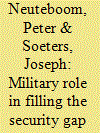

|
|
|
|
|
| Summary/Abstract |
During stabilization operations, the host nation and the international community are often confronted with a security gap, which could be a prelude to an explosive growth of crime and public disorder. In the absence of a functioning local police, an alternative is that the (international) military temporarily intervenes as interim police. This article analyzes how the Netherlands’ military performed during security gaps in three (post)conflict areas: Bosnia and Herzegovina, Kosovo, and Iraq. It concludes that army units frequently were involved in interim policing and de facto operated as hybrid organizations, without leaving the military paradigm behind. Policing is generally not seen as a primary task of the military, however. To adapt to the reality of security gaps and to increase the operational effectiveness in the field of public security, the military would benefit from reflecting on their current military paradigm and on what they could learn from current policing practices.
|
|
|
|
|
|
|
|
|
|
|
|
|
|
|
|
| 4 |
ID:
155828
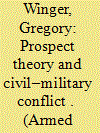

|
|
|
|
|
| Summary/Abstract |
This article investigates the potential use of prospect theory to understand civil–military disputes over the use of force. Specifically, I argue that distinct realms of responsibility can lead civilian and military authorities to inhabit different frames of reference when confronting the same crisis. This divergence in perspective causes each to asses risk in fundamentally disparate ways and ultimately produces competing policy recommendations. To illustrate this theory, I analyze the case of the 1976 Korean tree cutting incident. During this crisis, American military authorities define the situation narrowly as pertaining to the Korean peninsula, whereas the civilian leadership viewed it as part of a global challenge to American resolve. As a result, each party weighed the risks of escalation differently and promoted conflicting policy prescriptions.
|
|
|
|
|
|
|
|
|
|
|
|
|
|
|
|
| 5 |
ID:
155826


|
|
|
|
|
| Summary/Abstract |
Programs aiming to ease the transition from military to civilian life have increasingly focused on specific occupation areas where veteran skills might overlap with civilian job requirements. This research uses the American Community Survey to examine the occupations and industries that veterans tend to work in as well as how veteran incomes compare to similar nonveterans in each area. Results show that veterans tend to seek civilian occupations where military experience is likely to apply, as areas of veteran overrepresentation echo technical military functions. Furthermore, veterans generally tend to earn higher incomes than similar nonveterans in these areas of potential military–civilian overlap, but most income differences are relatively moderate. The results imply that programs encouraging transitioning military members to find a civilian occupation that is similar to their military experience may better assist those in military occupations with clear civilian applications.
|
|
|
|
|
|
|
|
|
|
|
|
|
|
|
|
| 6 |
ID:
155822
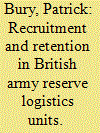

|
|
|
|
|
| Summary/Abstract |
The British Army Reserve (AR), and in particular its logistics component, is undergoing profound changes. The Future Reserves 2020 policy aims to expand the AR and make it more deployable on operations. However, to date, FR20 has struggled to attract the recruits required to man this more deployable reserve force, despite recruitment campaigns offering increased monetary benefits. This study sampled AR logistics soldiers’ reasons for joining, remaining in service, and mobilizing when deployed. Consistent with the previous research, the study found that soldiers who joined for institutional reasons were more associated with longer career intentions and mobilizing for intrinsic reasons. Soldiers who joined for occupational reasons were less satisfied with all elements of reserve service and deployed in order to fulfill their contracts. These trends suggest that recruitment campaigns that stress the pecuniary benefits of reserve service may attract soldiers less committed to reserve service and deployments and who are harder to retain.
|
|
|
|
|
|
|
|
|
|
|
|
|
|
|
|
| 7 |
ID:
155823
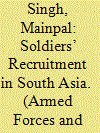

|
|
|
|
|
| Summary/Abstract |
This study uses a survey to examine the propensity of Indian Gujarati youth to enlist in the Army. The predictors were organized in three categories of demographic, individual characteristics of personality, routine and behavior, and socioeconomic and cultural aspects to measure their impact on the intention to enlist. The relationship between son’s intent to enlist and the father’s intent to allow the son’s enlistment was tested by logistic regression. The results of the study showed that non-Gujarati domiciles of Gujarat and the higher number of people working in the industrial plants had positive effect on enlistment propensity, whereas location of a factory near their residence had negative effect on the intention to enlist. Members of National Cadet Corps and those who did not have a family role model showed a positive intention to enlist.
|
|
|
|
|
|
|
|
|
|
|
|
|
|
|
|
| 8 |
ID:
155821
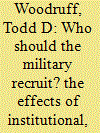

|
|
|
|
|
| Summary/Abstract |
The U.S. military spends millions of dollars and substantial institutional effort to understand enlistment motives and appropriately target incentives, recruiting effort, and marketing to prospective members. Similarly, researchers have worked for decades to identify, understand, and conceptualize enlistment motives. Much less effort has been made to understand the effect enlistment motives/goals have on individuals after they join. This research uses well-established enlistment motives/goals to identify and understand their effects on soldiers’ value to the military in terms of organizational identification and critical discretionary behaviors. Using multicohort cross-sectional data from future, initial training, and currently serving soldiers, this research finds that intrinsic enlistment motives/goals, such as altruistic service and self-enhancement, create greater relational and behavioral value than most extrinsic/economic enlistment motives/goals such as pay, gaining skills for future employment, and educational funding. Intrinsic enlistment motives/goals have a strong positive effect on perceptions of the organization, social satisfaction, organizational identification, and discretionary pro-organizational behaviors. Conversely, economic enlistment goals tend to be associated with higher levels of economic satisfaction but decreased organizational identification and pro-organizational behavior. Importantly, these effects tend to persist among soldiers who have been in the military for years. Contrary to the institutional–occupational framework, self-focused enlistment goals, both intrinsic and extrinsic, can creative substantial value for the military when they are aligned with organizational interests. Based on these findings, the practice of using enlistment motives/goals to maximizing enlistment without considering their long-term impact on relationship quality and behavior appears myopic and may fail to maximize long-term value for the military.
|
|
|
|
|
|
|
|
|
|
|
|
|
|
|
|
|
|
|
|
|